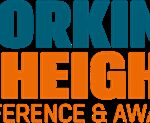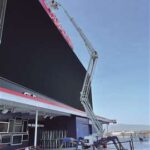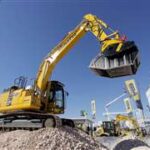vertical lift is a type of mechanical lifting equipment that moves loads, people, or materials in a vertical direction—straight up and down. It can refer to a wide range of lifting systems designed for different applications, including construction, warehousing, and industrial environments. Vertical lifts are commonly used when a more compact or efficient lifting solution is required in areas where space is limited or where height needs to be reached safely.
Key Types of Vertical Lifts:
-
Vertical Mast Lift:
-
A specific type of vertical lift that features a vertical mast and platform, designed primarily for elevating workers and tools to specific heights. It is highly maneuverable, typically battery-powered, and ideal for tight spaces or indoor applications.
-
-
Freight or Material Lifts:
-
These are used to transport goods or materials between different floors or levels in warehouses, factories, or storage areas. These lifts can be part of a building’s infrastructure and are designed to carry heavy loads, often operated by electric motors or hydraulic systems.
-
-
Passenger Lifts (Elevators):
-
Passenger lifts or elevators are common vertical lifts used to transport people between different floors of a building. They operate in a vertical shaft and can be powered by cables or hydraulic systems.
-
-
Vertical Reciprocating Conveyor (VRC):
-
These are often used in warehouses or factories to lift materials vertically between different levels. VRCs are typically designed for moving large or heavy items in industrial environments.
-
Key Features of Vertical Lifts:
-
Vertical Movement: The lift moves directly upwards and downwards, making it efficient for accessing elevated spaces without requiring horizontal space.
-
Compact Design: Many vertical lifts, such as mast lifts or VRCs, are designed to have a small footprint, making them suitable for confined spaces like warehouses, retail environments, or narrow aisles.
-
Safety: Most vertical lifts come with safety features such as guardrails, anti-slip surfaces, and emergency stop buttons to ensure safe operation.
-
Electric or Hydraulic Power: Vertical lifts are usually powered by either electric motors or hydraulic systems, depending on the application. Electric vertical lifts are often more common for lighter loads and indoor use, while hydraulic systems are typically used for heavy-duty lifts.
-
Capacity and Height: The weight capacity and maximum height that a vertical lift can achieve depend on the model. Some are designed for lighter, more mobile use (e.g., 10-50 feet), while others can carry much heavier loads and reach significantly greater heights.
Applications of Vertical Lifts:
-
Construction: Used for accessing higher levels on construction sites, especially in narrow or confined spaces.
-
Warehousing: In warehouse operations, vertical lifts can be used to move goods between different levels.
-
Maintenance: Often used in maintenance tasks that require working at heights, such as cleaning windows, replacing light fixtures, or performing repairs on equipment.
-
Material Handling: Used in factories or distribution centers to move goods and materials between floors or production lines.
Advantages of Vertical Lifts:
-
Space Efficiency: Vertical lifts take up less horizontal space compared to other types of lifts, such as scissor lifts or boom lifts, which require larger areas to operate.
-
Ease of Operation: Many vertical lifts, especially mast lifts, are easy to maneuver and can be operated by a single person.
-
Safety: Vertical lifts, especially powered models, are designed to offer a safe, controlled method of accessing heights or transporting materials, reducing the risk of injury associated with using ladders or scaffolding.
In summary, a vertical lift is a device designed to lift objects or people vertically, offering a safe and efficient solution for working at height or transporting materials in industries such as construction, warehousing, and maintenance. The type of vertical lift you would use depends on the application, the weight capacity needed, and the required lifting height.




